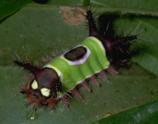
Click on any image to get a larger version.
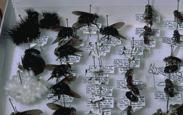 Although butterflies have been studied extensively, moths have been
studied much less, and there is relatively little known about
caterpillars. For many species, nobody knows what caterpillar makes
what butterfly/moth, so simply raising the caterpillars can yield new
information. In addition, many caterpillars can be quite damaging to
crops, so a knowledge of the parasitoids of the caterpillars can
sometimes be used for biological control. (A "parasitoid" is
different from a parasite in that the parasitoid kills its host in one
generation. For example, if a wasp's larvae burrow into a caterpillar
and eat it while it's growing, eventually killing it, then the wasp is
a parasitoid of the caterpillar. A parasite doesn't necessarily kill
the host, although it may, and a disease, even one that's always
deadly, isn't a parasitoid since the germs go through thousands of
generations before killing the host. If a bird just eats the
caterpillar, that's just called predation.) The photo to the left
is a box of various pinned parasitoids -- mostly flies and wasps.
Although butterflies have been studied extensively, moths have been
studied much less, and there is relatively little known about
caterpillars. For many species, nobody knows what caterpillar makes
what butterfly/moth, so simply raising the caterpillars can yield new
information. In addition, many caterpillars can be quite damaging to
crops, so a knowledge of the parasitoids of the caterpillars can
sometimes be used for biological control. (A "parasitoid" is
different from a parasite in that the parasitoid kills its host in one
generation. For example, if a wasp's larvae burrow into a caterpillar
and eat it while it's growing, eventually killing it, then the wasp is
a parasitoid of the caterpillar. A parasite doesn't necessarily kill
the host, although it may, and a disease, even one that's always
deadly, isn't a parasitoid since the germs go through thousands of
generations before killing the host. If a bird just eats the
caterpillar, that's just called predation.) The photo to the left
is a box of various pinned parasitoids -- mostly flies and wasps.
I'm interested in butterflies, but I chose the project more on the
basis of the location and time of year that it was scheduled. The
research site was at the field station "La Selva" for the Organization
for Tropical Studies (OTS) in Costa Rica. I had previously visited
the station for a couple of days as a tourist and I knew it is a
wonderful place to see all sorts of lowland tropical forest plants and
creatures. The project also fit perfectly with my vacation schedule.
Finally, since I was going to be in Costa Rica anyway, I added a week
before the beginning of the Earthwatch project to study Spanish at Ad
Astra -- a fantastic language school in a suburb of San José,
the capital city.
The most interesting language exercise we did was to improve fluency. The instructor put on a videotape of a movie I hadn't seen (Jumanji, starring Robin Williams), the sound was turned off, and my job was to give a running commentary of what was going on. It was nearly impossible at first because the tape just kept running and you couldn't slow down. After a couple of sessions, however, I was much better at it. You can try this at home to improve your own language skills -- be sure to use an adventure film with lots of action, and talk into a tape recorder (and it's probably better if there's nobody watching you, or guys in white coats are likely to show up at any time). Then you can play back the tape later, pausing it whenever there's a problem, and you can look up words you don't know, or mysterious points of grammar.
One rather disheartening thing happened on my next-to-last day there. The family I stayed with is a regular host for students at Ad Astra. A fellow who had been studying and staying with them for a couple of weeks then spent another week traveling in Costa Rica, and returned to spend his last night there before returning to the United States. He was a nice guy and I talked to him quite a bit (in Spanish, of course) and it was obvious that my Spanish was quite a bit stronger than his, although I'm not all that great. What was disheartening is that he works as a full-time instructor in Spanish in a high school in Texas!
The mother in my host family had recently retired as professor of agronomy, and was an expert on coffee and its diseases. She had even written a booklet on the biological control of insect pests of coffee, including the use of parasitoid wasps. It was only about 60 pages long, and half of that was pictures, so I was able to read it in my spare time during the week. The most important coffee pests are not caterpillars but beetles, but I still thought it was a pretty amazing coincidence. Of course she was able to answer a lot of questions I had. Reading the book also cast some doubt on the efficacy of using wasps/flies to control caterpillar pests, since the vast majority of the book concerned the use of various fungal diseases of the beetles, indicating to me that the fungus probably works a lot better than parasitoids. It's hard to imagine an easy way to raise vast numbers of parasitoids, but raising a lot of fungus isn't too hard.
July/August is the wet season in Costa Rica, and it was absolutely pouring rain. It was the heaviest I'd ever seen there, and as I stood at the front door of my hosts' house with my mouth hanging open and looking at the street that had become a raging river, I noticed that all the neighbors were doing exactly the same thing, so it must have been a lot of rain. With so much rain, of course, it was a pain getting a taxi, but I finally did and we took off for the hotel. I arrived a bit after 6:00, and found that the group had gone to dinner, but luckily the restaurant was only a few hundred meters from the hotel and I got there in the middle of the meal.
I would have expected the meal to be in some typical Costa Rican restaurant as a suitable introduction to the country for the folks who had just arrived, but surprisingly, it was at an Italian restaurant. But the food was good, and I had no complaints, having eaten the standard Costa Rican "gallo pinto" (beans and rice) for a solid week during my Spanish school. The food was good, and the dessert -- tiramisu -- was great.
This group was quite a bit younger, on average, than the members of the previous two Earthwatch groups in which I've participated. There were only two of us old geezers and the rest were in their 20s and 30s. There was even a really bright high school kid named Bob who was 17 who was my roommate both at the hotel and at La Selva.
Besides Bob, the only other male volunteer was Nick who is a map designer at Microsoft and who shared my interest in photography. The other nine volunteers were women -- three university students from the United Kingdom (Claire, Katie, and Lindsay), another student from the United States (Emilie) four school teachers (Suzanne, MaryAnn, Sylvia, and Susan), and finally an artist (Joanne -- the other "geezer").
Aside from me, only Sylvia had ever been on an Earthwatch trip before, and she had done the one on katydids in the Amazon basin in Peru. After dinner, we got the usual lecture on snakes and stinging ants and botflies (which I will also describe in what follows) from Grant, the principal investigator, but nobody seemed particularly worried (or at least they kept their mouths shut), so it looked like a pretty good crew. Emilie had spent quite a bit of time in Central America, as had Nick, and Suzanne and Sylvia were pretty fluent in Spanish, due to extensive time spent in the Dominican Republic and Peru, respectively.
I think everybody went to bed shortly after the dinner. Or at least if they didn't go to bed and instead attended wild parties nobody invited me.

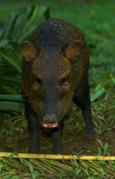 In addition to the stuff we were looking for, there were lots of
other cool animals to see. The photo on the right is a clear-winged
butterfly. Most butterflies have scales all over their wings to
produce the colors, but clear-winged butterflies are missing many
of them, and they're hence, partially transparent, and thus hard to
see and catch. On the left is a collared peccary.
In addition to the stuff we were looking for, there were lots of
other cool animals to see. The photo on the right is a clear-winged
butterfly. Most butterflies have scales all over their wings to
produce the colors, but clear-winged butterflies are missing many
of them, and they're hence, partially transparent, and thus hard to
see and catch. On the left is a collared peccary.
We hiked the kilometer or so into the station and had time to check in, get our bags to our rooms and get settled a bit before lunch. After lunch there was a nature walk with Gerardo, one of the resident naturalists and we spent two or three hours hiking around on the trails looking at stuff. I figured that since I had quite a bit of experience in Costa Rica I'd hang back so the others would be nearer the guide both to hear him better and to be in a better position to see animals and birds before they were frightened away by a mob of 13 people. Nick had also spent a fair amount of time in Costa Rica so he joined me at the back of the pack for much of the walk.
Gerardo is apparently quite an expert on birds, and since I was carrying my monster binoculars he asked me if I were a birder. I told him I was interested, but wasn't what you could call a serious birder. Of course just as we started down the trail he spotted a bird way up in the canopy that was completely back-lit so all we could see was the silhouette, and I got my final exam question on the spot: He asked me, "What's that?"
I could see that it was a hefty bird with a big beak, and since I'd seen a bunch of them already at the La Selva check-in, I guessed "Montezuma Oropendola", and luckily I got it right. I wasn't sure how long I could preserve my 100% accuracy record, so maybe that's another reason I spent time at the back of the pack. Gerardo was very good, however, and in spite of the fact that I was at the rear, I did see quite a few new things.
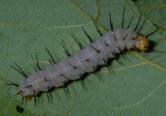
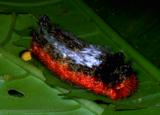 Here are a couple of caterpillars we saw. The one on the left
we called a "red-footed fuzzy-wuzzy. We didn't see enough
examples of the one on the right to give it a name. By the way,
the little dot to the lower left of the caterpillar on the right
is called "frass". See below for more information.
Here are a couple of caterpillars we saw. The one on the left
we called a "red-footed fuzzy-wuzzy. We didn't see enough
examples of the one on the right to give it a name. By the way,
the little dot to the lower left of the caterpillar on the right
is called "frass". See below for more information.
The two main jobs were catching new caterpillars and taking care of those that had already been captured. Catching them was a bit harder than I'd thought -- many of them are colored cryptically to make them hard to see, and they really aren't all that common. As is the case for any other creatures, it's tough to find the first one, but once you get a "search image", the next ones (of the same type) are a lot easier to find. The photos that advertise the project of course show giant, outrageous caterpillars, but the vast majority are small and green or brown. We did get quite a few outrageous ones, though. Over the course of the entire project I think our team caught nearly 600 in total.
There are all sorts of tricks you learn when searching for caterpillars. Rolled up leaves are a likely place to look, but sometimes there were other things living in the leaf rolls, spiders being the most likely possibility. You also looked for recent leaf damage and caterpillar "frass" (a nice word for caterpillar shit -- caterpillars are incredibly inefficient eaters and only convert a tiny fraction of the leaves they ingest into caterpillar; the rest is converted into frass). Of course certain plants were much more likely to be hosts for caterpillars, or hosts to caterpillars in which Lee and Grant were particularly interested, so we spent a lot of time looking at those plants. One of the problems with Earthwatch projects is that 2 weeks is barely long enough to get pretty good at something, and then it's time to go home. After two weeks, I was pretty good at finding caterpillars, and then I suddenly found myself retired. But God help any tomato worms that try to gobble down the plants in my garden!
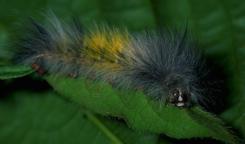
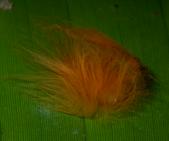 The caterpillar on the left we called "Elvis" because of the
hairdo, and as soon as my wife saw the one on the right, she
called it the "Don King" for similar reasons.
The caterpillar on the left we called "Elvis" because of the
hairdo, and as soon as my wife saw the one on the right, she
called it the "Don King" for similar reasons.
Once you caught a caterpillar, you'd also take enough leaves from the
plant it was eating to keep it in food for a couple of days, and you'd
record exactly where you were so that it wouldn't be too hard to find
fresh food when the old stuff was eaten or rotted. Then you'd put the
caterpillar and the food in a plastic bag. You were also supposed to
poke the caterpillar to see its reaction -- did it thrash? drop? bite?
do nothing? It was pretty important to keep the bags of captured
caterpillars in the shade, or you'd come back with steamed or roasted
larvae.
Since Grant and Lee were at least as interested in the parasitoids of caterpillars as they were in the caterpillars themselves, there were quite a few discussions about the sorts of animals that make a living eating caterpillars. In addition to the obvious birds, ants, and wasp and fly parasitoids, it turns out that monkeys also eat many of them. We commented, of course, that this particular collection of Earthwatchers was, in some sense, the most dangerous predator of the caterpillars since we were oblivious to size, color, taste, or anything else. If it was a caterpillar, we were determined to catch it. Since the standard monkeys are big-time predators, at that point many of us started to refer to ourselves (and to humans in general) as "ground monkeys". In fact, for many of the things we humans do, "ground monkey" gives a more accurate image of our behavior than "human" or especially, "Homo sapiens".
When they arrived at the lab, the bags were numbered, various information about the caterpillars was recorded, and the bags were hung on strings like clothes on a clothesline.
Every morning, somebody had to look in each bag to see how the caterpillars were doing. Were they low on food? Were they dead? Had they pupated? Had any of the pupae eclosed (emerged as moths or butterflies or parasitoids)? Were the bags so full of frass that they had to be cleaned out?
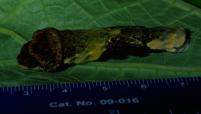
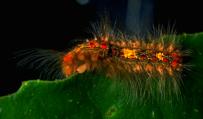 The caterpillar on the left was a colorful, hairy beast, but the
one on the right looks just like a piece of bird shit to protect
it from lots of predators.
The caterpillar on the left was a colorful, hairy beast, but the
one on the right looks just like a piece of bird shit to protect
it from lots of predators.
The job of taking care of them was called "zoo", and unfortunately I did it for the pupae on the first day. Since Lee and Grant (Dyer and Gentry; not Robert E. and Ulysses S.) had not been in the lab for quite a few days, quite a few of the pupae were in a state of advanced decay, and it was pretty disgusting going through some of the bags.
"There's no caterpillar in here."
"Sure there is -- did you dig
through all the frass?"
"No... Yuck! Here's something, but I think
it's dead -- yeah, it's really dead."
"Was it killed by
parasitoids?"
"How do I find out?"
"Squeeze it until it pops and
see what's inside."
After the first day, since "zoo" was performed daily, things were never very bad.
A couple of people became "botanists" in the sense that they learned most of the important food plants for our caterpillars. When the food ran low, they'd go out into the field and find more leaves of the same species. I found this very difficult, and I had trouble even when I had a sample leaf with me. In the tropical rainforest there are so many species of plants that you can look at ten plants in a row and every one is different, and I'm hopeless even with the relatively small number of plant types in California. Sylvia had a real talent for botany, and when I accompanied her on food-seeking trips I felt useless, although I could usually find a couple of new caterpillars while she did all the work of finding the food.
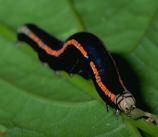
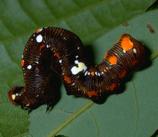 Both of these caterpillars are "aposematically" colored -- colored
in warning colors like red, orange, black, or yellow. They generally
taste bad.
Both of these caterpillars are "aposematically" colored -- colored
in warning colors like red, orange, black, or yellow. They generally
taste bad.
Some people did lab work -- weighing things, recording the data,
entering the data in computers, preparing solutions of plant or
caterpillar extracts, et cetera. Since I went to Costa Rica to get
away from computers and since I'd done my time in innumerable labs in
college, I tried to avoid this sort of work whenever possible.
Luckily, there was a job that I fell in love with which was so
terrifying to some other Earthwatchers that they'd cheerfully spend
hours in the lab to avoid doing it -- nectaries.
To test the toxins (or perhaps simply bad-tasting chemicals), extracts of either the caterpillars themselves or of their host plants were prepared by various means and mixed with sugar water. Then pure sugar water and the adulterated water were offered to a typical predator to see if there was a difference in consumption. The "typical predator" we used was Paraponera clavata -- the "bullet ant".
Bullet ants are huge -- nearly an inch long -- so they can consume a lot of sugar water. The two nectaries with the control and adulterant each contained about a gram and a half of liquid, and in an hour the ants could drink most of one if they liked the taste. We made the so-called nectaries from centrifuge tubes that had a plastic snap top which we'd weigh before and after an hour with the bullet ants.

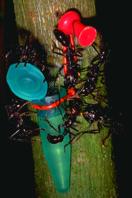 On the left is a nectary surrounded by bullet ants. On the right
is a US nickel with a couple of bullet ants for a size comparison.
Of course we were sure that Murphy's law would insist we get stung
when getting the photo with the nickel, but for some reason, the
law failed to operate.
On the left is a nectary surrounded by bullet ants. On the right
is a US nickel with a couple of bullet ants for a size comparison.
Of course we were sure that Murphy's law would insist we get stung
when getting the photo with the nickel, but for some reason, the
law failed to operate.
There is a downside to using bullet ants, however. I originally
thought the name "bullet" referred to the fact that the ants are about
the size of a rifle bullet, but in fact it refers to the fact that if
you're stung, it feels like a bullet going in. Other descriptions
included "it feels like being injected with boiling sulfuric acid and
then twisting the needle for 4 hours" and others equally colorful.
Apparently it also hurts for a long time -- 2 to 4 hours or more of
intense pain. The reaction varies from person to person, but I never
ran into anyone who'd been stung who didn't say it hurt a lot. The
ants also have massive jaws so they can also bite like any other type
of ant, but unlike fire ants, for example, that spit formic acid into
the bite, the bullet ant bites are more like a hard pinch -- and I know
that from personal experience.
The bullet ants separated evolutionarily from the other ants quite a long time ago and are closely related to wasps. They have a complete stinger that they can use to sting repeatedly. Almost all of the regulars at La Selva had been nailed a few times by accident when they brushed against a tree with a bullet ant nest in it and then somehow annoyed the ant by getting it caught in their clothing or something.
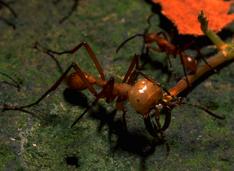 On the left is a close-up of some army ants that we discovered
while we were working with the bullet ants. The big soldier
certainly has an impressive set of jaws (and probably much
larger muscles in the head to use them), but I'd prefer to
get bitten by 100 of them than one bullet ant!
On the left is a close-up of some army ants that we discovered
while we were working with the bullet ants. The big soldier
certainly has an impressive set of jaws (and probably much
larger muscles in the head to use them), but I'd prefer to
get bitten by 100 of them than one bullet ant!
Generally, when you'd get to the tree with the nest, there might be
one or two ants visible on the bark and it was no problem putting the
nectaries on their little hangers made of bent paper clips, but when
you came to collect the nectaries after an hour, they'd usually be
swarming with ants. Using some sort of a tool, you'd brush the ants
away from the nectaries until you thought it was safe, and then you'd
pick them out of their hangers. Grant and Lee used sticks as brushing
tools and their fingers to pick off the nectaries. I had a giant pair
of tweezers that I used for both tasks.
I think the tweezers had a bunch of huge advantages -- on a stick, it was often hard to see the ants, and they could crawl up the stick and sting you. Against silver-colored tweezers it was usually obvious how close the ants were getting to your fingers. The sticks sometimes broke and the tweezers didn't. With the tweezers, you could actually pick up and gently move recalcitrant ants and with sticks, you could only brush them. Finally, the tweezers were always the same, and each stick was different. The disadvantage of the tweezers was that they were only about 30 centimeters long; you could get as long a stick as you wanted.
I think that since Grant and Lee used the sticks many of the members of our group felt that the sticks were a more "official" way to go. But after only a few experiments, my usual nectary partner, Bob, and I were in total agreement that the tweezers were vastly safer.
Early on (I forget if it was the second or third day) Lee took us out in teams of 6 to try our hand with the nectaries. For practice we just used sugar water in both so if you dropped one, no data would be lost, and everybody got the opportunity to try putting them in and taking them out, although I think a few of the more sensible of the volunteers declined even to try it.
A couple of us (Katie and I), however were "adrenalin junkies" and loved the excitement. Another team (Emilie and someone else) also wanted to do it. So we flipped a coin to see who got to go first and Emilie's team "won". The next morning they started the nectaries and most of the rest of us were out collecting caterpillars.
There were 11 nests of bullet ants to service, and Emilie's team managed to make a complete pass and were working on the second nest when Emilie got stung. We happened to be collecting near them and it sure didn't look like she was enjoying the experience. She was talking calmly enough, but she was holding one finger high in the air, and her face was covered with droplets of sweat. It was so painful that she headed back, so Bob and I volunteered to finish the collection.
Bob and I took turns on the nests with one of us using the tweezers and applying every scrap of our concentration to the few hundred square centimeters around the nectaries. The other was responsible for everything else -- mainly watching the ground around his partner's feet to make sure nothing crawled up them. If there was a lot of nearby foliage around or vines overhead, you'd also keep scanning it for ants. Needless to say, from time to time you'd check your own boots as well.
Bob was great to work with -- you didn't want a partner who would freak out; just someone who would calmly say, "You've got one crawling up your left boot." Or even better, "There's an ant 12 inches from your left boot -- 8 inches -- 4 inches", at which point you'd move your left boot. To maintain the proper atmosphere, the last thing you wanted was someone you simply shouted, "Watch out!!!!!!"
We decided that working with the ants was like an exercise in Zen meditation. It was absolutely imperative that you (and your partner) remain perfectly calm, and remain perfectly concentrated on the task at hand. When you were working the tweezers, you couldn't afford to think about anything else but a 20 centimeter radius around the nectaries, and if you were the guard, about the danger zones -- the area around your partner's boots, the nearby plants, any vines running overhead, and the area around your own boots. No matter how long it took, or however many ants there were swarming around the nectary, it was critical not to get frustrated -- just keep moving the ants away one by one, and eventually there would be an opening when you could remove the nectary.
You could judge exactly how fast the ants could move, and even if they were half of the distance up the tweezers, you knew that you still had plenty of time to knock them off, if you kept your wits about you. Lee told of one volunteer from the previous trip who had simply frozen when the ant was running up his stick. He didn't even drop it, and just waited to get stung. I mentally "practiced" dropping the tweezers many times, although I never actually needed to do so.
For us, at least, it was a perfect exercise in concentration, and we joked that what we needed to do was to have a workshop for kids with ADD -- "attention deficit disorder". We noticed that when we were working with the ants, there wasn't even the tiniest possibility that our attention would lapse. The kids in our ADD camp would learn to do the same -- especially after the first accident. And we figured we could charge their parents a fortune.
For the next few days, Bob and I did almost all the nectaries, and we got so we were doing 3 sets in the mornings and 2 in the afternoons. We had been told that on the previous trip there was a pair who had done 8 sets in one day, but that was hard to believe. It took about a half hour to hike to the nectaries, so when we got mountain bikes, we found we could get there in 7 minutes, and we did even better. We eventually managed to get in 8 sets in a single day ourselves.
Katie and Claire went to school together, were good friends, and they also decided to give the nectaries a shot. On the first afternoon that they tried, however, they ran into an extremely heavy rain, and although the rain kept most of the ants off the trees, or at least stunned, they got so wet that they passed for another day. Claire told stories of Katie snapping off ants with her fingers, so I knew that she was going to give me some stiff competition in the "lowest IQ" competition.
As we were getting near the end of the two week session, Lee asked me if I would be in charge of the nectaries and try to get 16 of them done in two days plus an afternoon. I recruited Katie and Claire for the afternoon work, and we got 2 the first afternoon, 8 the next day (5 in the morning and 3 in the afternoon), and then it was easy to do the last 6 on the final day.
Katie and Claire also seemed to do quite well, with the proper Zen approach, except for the fact that Katie tended to take off her rucksack at each tree. Unfortunately, she set it next to the ant tree, and although she got perfect marks for her Zen performance at the tree, putting on a rucksack with ants crawling on it wasn't such a great idea, and one of them stung her four or five times on her leg. She's a real trooper though -- she finished the set anyway.
Bob and I did about 25 sets total, and there was only one truly terrifying incident. As Murphy's law requires, it was on the final pass on the final day. One of the paper clip hangers was a tiny bit too big, and the nectaries tended to drop through too far, so I decided to tighten it up a bit just after I'd removed the next-to-last nectary. I was messing with it and I have no idea what happened, but I saw a bullet ant sitting on my left hand (although I did all my tweezer work with the right hand). Then I felt a very hard pinch on the left hand and I was thinking that in the next tenth of a second I was going to feel the boiling sulfuric acid. As they say in the stories, as my life began to pass before my eyes, my right hand was moving at blinding speed to sweep off the interloper. I was incredibly lucky, and the pinch was only a bite and not a sting, and I swept off the ant. Unfortunately, I was holding the tweezers in my right hand at the time and I stripped off a nice chunk of skin with them when they hit the back of my left hand. The bite hurt for about 10 seconds -- much better than 4 hours or more. I've still got a scar from the moving tweezers.
I did almost all of my sets with Bob as my partner, but I did do one set alone and two sets with Susan. The solo set was much less scary than the sets with Susan. I have no idea why she volunteered to do them with me -- she was totally terrified of the ants. I think she may have wanted to prove something to herself, but I knew that she didn't even like to walk off the trails (almost all the nests were a few meters off the trail into the forest) and when I talked to her roommates afterwards they told me that for the entire night and morning before we went out, she obsessed about what she was going to do. I did the actual ant work, and she just watched my boots, but often stood so far back that I didn't trust her to see what was going on, so I had to check continuously as well. When an ant did come near, I got the dreaded "Watch out!!!!!!" reaction. In any case, she did two sets with me before Bob walked by searching for caterpillars, and she traded jobs with him. He did two more with me, and then had to go back for lunch (I was planning to do 5 that morning and had a sack lunch). So I did the final one alone, and it took a bit longer due to some additional paranoia, it was psychologically easier for me than doing it with Susan.
Susan was worried about nearly everything, it seemed, and she certainly realized it herself. She often said that she was "actively worried" about this or that. I think she was actively worried about the nectary crew whenever we were out. It was fine with me if she was actively worried about me while I was out, as long as I wasn't around to hear about it.
Since the bicycles there spend a great deal of time in the pouring rain, in 100% humidity, and in high temperatures, they're quite a study in rust. You'd probably not choose them to race in the Tour de France, but they were sure quicker than walking. On the morning when I was going with Susan to do the nectaries, as I unlocked the bicycles, I told her, "Don't even think about trying to shift the gears, and the brakes are shot." She totally freaked at the news about the brakes, even though the trail is dead flat, is solid concrete, and probably wide enough for 3 bicycles abreast if you were careful. But what really blew my mind is when she wanted to get off the bicycle and walk down the steep hills. The trail follows a sluggish, meandering river and never goes up or down more than a couple of meters along its entire length!
Susan is highly intelligent, and was fun to talk to, but it drove me nuts working with her on the nectaries. She did a great job on all the "sane" tasks she tried.
The way most of the showers in Costa Rica work is that there's an electric heating element in the shower head and as long as the water is flowing, the heater is on. So the faster the water moves, the less it is heated. If you want it hot, you just turn down the water pressure. It was never boiling hot, but in the constant high temperatures at La Selva, you never wanted a hot shower -- just a warm one. On the way back to San José, one of the women was really happy to go back because she was so sick of the ice-cold showers. Apparently she never figured out how they worked, and had the water running at full blast, and consequently as cold as possible!
The dining room consisted of a bunch of tables that would hold 6 to 8 people. It was cafeteria style, but always with plenty of simple food. I don't mind eating rice and black beans 3 times a day, but that began to grate on some of the volunteers. There was always fruit, some vegetable, and usually some kind of meat. It was hardly ever clear, however, exactly what kind of meat it was. We decided it was probably better not to ask, but just for good measure we carefully checked on the health of the stations' "mascot", a raccoon-like coatimundi that probably could have become "carne tipica".
The only name we ever got for the meat from the cafeteria staff other than "carne tipica" was "mano de piedra" (hand of stone). There was a poster of the poisonous snakes of La Selva outside the dining hall, and one of those featured was called "Mano de piedra". It sure didn't look like snake meat, or else it was a really big snake.
I remember one day a couple of Earthwatchers were arguing about what they had been served for breakfast. One of the experienced researchers set them straight: "You had gallo pinto (beans and rice), a piece of fruit and an egg. I've been here for 15 months, and without exception, that's what you get for breakfast every day."
One of the things I loved about the dining room was that it was truly casual. It was common to have a couple of researchers stagger in near closing time totally exhausted and covered with mud, going through the line. I did it a couple of times myself.
La Selva itself consists of only a few thousand hectares, but it is connected via a corridor to the relatively huge national park Braulio Carrillo, so it would not be impossible to find rare birds, or even big cats. Within the last few years, a remotely triggered camera even caught a jaguar in La Selva. Cougars have been seen, and quite a few of the smaller wildcats. There were peccaries all over, as well as a bunch of smaller mammals.
For the benefit of the researchers, the trail system is incredibly well marked and well organized. Every 50 meters is a sign with the distance to the beginning of the trail marked on it. So if the sign said "STR 2000", you knew you were 2000 meters out on the STR trail. All the numbers get smaller as you approach the lab, so unless you were completely dysnumeric, it's impossible to get lost.
In addition to the trails, there's a grid of poles every 50 meters throughout the property, although they weren't quite so easy to find. As a side effect of this, there were a few trails that went in perfectly straight lines, following the poles. These, of course, were nightmares to hike, because they went in a straight line no matter what. Hills, rivers, and swamps had no effect. The curvy trails were a lot more fun. In fact, on the first of my two days off, I took a walk along a trail that followed a stream along the boundary of La Selva for about 3 or 4 kilometers until it dead-ended into one of the beeline trails. I had intended to miss lunch, so I took my time. But when I turned onto the straight trail, it was such hard work that I wasn't really looking at nature, and I decided that if I stepped on it, I could make it back for lunch. I kept going faster and faster and I did make it back at 12:15 (lunch runs from noon to 12:30). On that day I appeared to be one of the exhausted researchers stumbling into lunch covered with mud and sweat.
Near the laboratory all of the trails are like sidewalks, and made of concrete. This makes it easy to run most nearby experiments since there's no need to deal with deep mud as long as you're not working too far away. There's also one superhighway that runs all the way to the edge of the property -- about 6 kilometers -- that's quite wide, made of concrete, and has no stair steps. It follows the big rivers Puerto Viejo and Sarapiqui so it's almost level. There are bicycles available that can be borrowed which can cut out a lot of travel time.
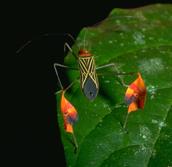
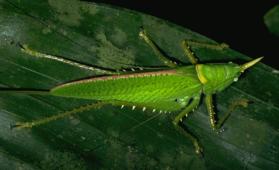 Here are a couple of insects I found. One is just a large katydid
with a horn on its head, and the other is a bug with growths on
its legs that look like little leaves.
Here are a couple of insects I found. One is just a large katydid
with a horn on its head, and the other is a bug with growths on
its legs that look like little leaves.
With the exception of the superhighway, most of the concrete trails turn to dirt (or mud, depending on the season) a few hundred meters out. Even though it was the wet season, none of the ones I tried were too bad, although I understand from others that there were a couple of sections that were more "interesting". Also, having done some time on a previous Earthwatch trip in Ecuador during the worst part of an "El Niño" event, it takes quite a bit of mud before I consider it "interesting".
The main office, the dining hall, some housing, and a few other buildings for the station are located on a road on the north side of the Puerto Viejo river. There's a huge suspension bridge across the river to an open area containing labs, lecture halls, more housing, a library, et cetera. The bridge is only wide enough for foot or bicycle travel, so in the rest of the La Selva reserve, there are no motor vehicles.
If you watched the timing and where you put your feet, you could really get the bridge shaking, sort of like the one over the Tacoma Narrows in Washington. There was a good system of handrails so it would have been almost impossible to go over, but it would have been a long fall into the river if you did, so shaking the bridge was a lot of fun. Also, just before you got to the far side of the river there was a spot on the bridge where you could toss over fruit and a bunch of fruit-eating fish would gobble it up. They even ate banana peels, and we'd save ours from breakfast for the feeding on the way to work. I was like a school of pirana the way they fought for the fruit.
All the Earthwatchers stayed at the "River Station" that is a few hundred meters beyond the main clearing with the labs. It was about a ten minute walk from the dining room and about 4 minutes from the lab via a concrete trail. We called it the "Fer de lance trail" because a few hefty poisonous snakes with that name (called "terciopelos" in Spanish) had been spotted on it. It was a little strange to walk along that trail at night with your flashlight carefully sweeping every square inch of the trail in search of snakes, and at the end, to step into a fairly modern lab complete with a high-tech computer room.
The availability of computers and the flakiness of the phones turned many of our group into email junkies. Some of them insisted on checking their mail three times a day, but I managed to keep my daily visits down to one.
Finally, there was cold beer available. At the end of the day, which for us was usually around 4 or 4:30, it was "Miller time", and we'd go over to the dining hall for a beer. The beer came out of a machine that required some strangely shaped tokens which had to be purchased during office hours that didn't usually correspond with Miller time. So although most of us carried nothing like money or wallets or anything, many of us did always have a few beer tokens jingling around in our pockets.
There's also the eyelash viper (Bothrops schlegelli), closely related to the terciopelo, but smaller. The other common ones are various varieties of coral snakes which have venom that's even more toxic, but they are skittish, smaller, and have rear fangs so it's harder for them to deliver their dose.
 When we arrived, Grant was, of course, asked about the snakes, and he
said that we'd be lucky if we saw any. Well, we were sure lucky,
since I saw at least 10 of them. Most were non-venomous, including a
vine snake, a boa constrictor, and a couple of others of unknown type,
but I did see a fairly big coral snake on the path (photo on the
right), and a couple of small snakes that might have been terciopelos.
When we arrived, Grant was, of course, asked about the snakes, and he
said that we'd be lucky if we saw any. Well, we were sure lucky,
since I saw at least 10 of them. Most were non-venomous, including a
vine snake, a boa constrictor, and a couple of others of unknown type,
but I did see a fairly big coral snake on the path (photo on the
right), and a couple of small snakes that might have been terciopelos.
Lindsey seemed to be the "expert" at finding snakes, and her list included a rather large terciopelo (1.5 meters or so). I think at least everyone saw at least a couple. On the last night, I was walking back to the river station on the fer de lance trail with Emilie, and she complained that she hadn't seen any snakes. She hadn't quite finished the sentence when she suddenly stopped and a small terciopelo-like snake crawled across the path in front of her.
An interesting story I heard about the main clearing on the far side of the bridge from the dining room is that since it's covered with grass, it has to be mowed every now and then (and the way the grass grows, I suspect it was cut fairly often. When the grass is tall, it's a pretty good hiding place for terciopelos, and as the lawnmowers advance, the snakes are chased into a smaller and smaller area of uncut grass. Apparently cutting the last few square meters can be quite a hair-raising experience.
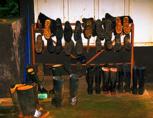 We may have been insane, but we weren't crazy, so almost everyone wore
high rubber boots almost all the time, which generally came to just
under the knee. The vast majority of snake bites are on the foot or
ankle when you accidentally step on one, and even though a big
terciopelo might be able to get its fangs through the rubber, it would
certainly lose the vast majority of its venom between the boot and
your leg. Almost all of the nasty snake-bite stories involve some
idiot who's barefoot or wearing sandals. The local farmers are bitten
regularly, probably because they have their hands in the undergrowth
far more often than is healthy. On the left is a photo of the boot
rack at the river station. Mine are the ones in the lower-left corner.
We may have been insane, but we weren't crazy, so almost everyone wore
high rubber boots almost all the time, which generally came to just
under the knee. The vast majority of snake bites are on the foot or
ankle when you accidentally step on one, and even though a big
terciopelo might be able to get its fangs through the rubber, it would
certainly lose the vast majority of its venom between the boot and
your leg. Almost all of the nasty snake-bite stories involve some
idiot who's barefoot or wearing sandals. The local farmers are bitten
regularly, probably because they have their hands in the undergrowth
far more often than is healthy. On the left is a photo of the boot
rack at the river station. Mine are the ones in the lower-left corner.
In any case, you never saw anyone out at night without a flashlight, or tightly glued to some friend with one. I also made it a point to have a spare set of batteries at all times.
I brought an old pair of rubber boots with me, but they were too small and I had a couple of huge sores at the end of the first moderate hike. Since dozens of people abandon their boots at the end of the trip, I was sure that among the dozens of pairs outside the river station, some were available, so I selected a pair that had bone-dry mud on the outside, and just left mine there. I think that was the right thing to do, since every couple of days I inspected my own boots, and the mud was still wet nearly two weeks later due to the 100% humidity, so it was clear that the boots I'd borrowed hadn't been used in ages.
The boots I borrowed were certainly near the end of their useful life -- the linings were in tatters, and after a couple of days, a hole appeared just above the sole. I wrapped it with duct tape, which lasted for the rest of the trip. Also, once when I was pulling them on, a big chunk of rubber simply tore out of the top of the boot, making it even more likely that I'd selected an ancient abandoned pair.
Others in our group were not quite so interested in even more tropical biology, so there was almost always a card game going on. My roommate Bob was particularly good at cards, and I'm sure that if any money was involved, he left La Selva a richer man than when he arrived.
One guy I met told me that he had also spent a lot of time at another OTS station at Las Cruces in southern Costa Rica working on reforestation of cow pastures. He said that he hated the cow pastures because when they were overgrown they were very difficult to walk in, they contained a lot of chiggers, there was a lot of mud, and they were just generally no fun. I told him that I had myself experienced those cow pastures, and that once I'd had a fairly unpleasant experience getting stuck in one as the sun was going down.
After I described my experience, he told me that although it sounded bad, I was lucky because he'd recently heard a story from a very famous researcher down there who had had a truly nightmarish experience getting stuck in those fields after dark. Had I ever heard of Paul Ehrlich?
Well, it turns out that Paul and I had shared the "truly nightmarish experience", but apparently Paul has generated a much juicier version of it than I have. I'll have to get him to tell me his version so I can get more sympathy in the future. It was fun, however, hearing somebody tell me a "legend" where I was in fact one of the original participants!
I met a bunch of other nice folks, and enjoyed talking to them, but few of those conversations generated stories worth retelling here, with the major exception of the woman named WAG.
"WAG" was the name given her by the female members of the Earthwatch team. It stood for "weird arachnid girl". Although I'm not positive exactly how to parse that (Was it a weird girl who studied arachnids, or a girl who studied weird arachnids, or both?) but I suspect the Earthwatch girls meant the former. I think there was surely a bit of jealousy involved because I know that I and quite a few other males at La Selva found her very attractive. Her real name is Eileen.
But she certainly did study weird arachnids -- amblypygids, to be exact. The common name (she claimed) was "whip spider", but most of the references I can find seem to call them "whip scorpions". In any case, they look something like spiders and something like scorpions, but without the stinger. At least I can assure you that the first time you run into one in the wild your heart will skip a couple of beats.
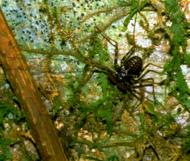 Here's a photo (not a great one, unfortunately) of an amblypygid.
To see the length of the antennae, it's probably a good idea to
click on this thumbnail to see the larger version.
Here's a photo (not a great one, unfortunately) of an amblypygid.
To see the length of the antennae, it's probably a good idea to
click on this thumbnail to see the larger version.
I'd admired her collection in the lab and talked to her a bit about
them, but on her last night at La Selva at dinner she announced that
she was going out to hunt for amblypygids and did anyone want to come?
It sounded crazy enough that she immediately had about ten volunteers
including about five of us Earthwatchers. Based on the enthusiastic
help she got, I'll bet she considers using Earthwatch as a source for
crazed general-purpose laborers in the future.
We waited until it got good and dark and then assembled in the lab to discuss strategy. Apparently they don't bite or sting, and the easiest way to catch them was first to find them on the trunks of the larger trees with the huge "flying buttress" type roots and then to slap an opened zip-lock plastic bag over them and work them into the bag that you could then zip shut. Then you could slip a plastic bottle into the bag, work the amblypygid into it, and put on the cap. The only piece of data she needed was how high up on the trunk they were when we caught them to test some theory about whether males or females should be higher up to properly distribute pheromones.
We were each issued our zip-lock bag and we were about to leave when Eileen asked if any of us had a snake-bite kit. Of course we didn't -- we'd come directly from the dining hall -- and she said, "Well, I really hate to go out there with only one kit!"
It really is hard to see much at night, and those big trees are a good spot to find terciopelos, so I just decided to take special care with the flashlight before I made any moves at all.
We were wildly successful at catching them. I used the first one I found to discover just how fast they were, and I suspect most of the others missed on their first try as well, but I was able to catch all the rest of them. I think I got 7 or 8 of them total. Toward the end, since I became convinced that they really don't bite or sting, I just used my fingers to brush them into a plastic bag and the captures were much more efficient after that. Most everyone else was highly successful as well.
In fact, after we got the hang of it, Eileen had a hard time catching any of them herself because she was constantly surrounded by people who needed containers, the marker pen, or the tape measure. Since Eileen was the only person with a tape measure, when you caught one, you'd stand next to a tree and notice how high up on your leg or chest the amblypygid was when you first saw it. Then when you took it to Eileen, you'd measure from the ground to your belt, or to the beer tokens in your pocket, or wherever, to get the numbers she wanted. Much of the time, Eileen just handed out stuff, recorded data, and stuffed animals in her backpack. At the end, I think we got 40 total, which we thought was pretty impressive.
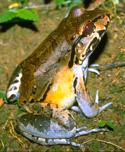 When you're wandering around in the jungle at night, you see all sorts
of other stuff. There were dozens of tachynid spiders, I saw three
scorpions (of which we captured one), bullet ants (they're said to be
more active at night), centipedes, and frogs. There's a really
impressive large frog called the "red-eyed smoky jungle frog" which
you can spot at long distance by putting on a headlamp and sweeping
the ground. When you see two big red spots in the distance, you've
found a frog. We saw one, and were able to get within about 3 meters
of it before it plunged down its hole. On the right is a photo of one.
When you're wandering around in the jungle at night, you see all sorts
of other stuff. There were dozens of tachynid spiders, I saw three
scorpions (of which we captured one), bullet ants (they're said to be
more active at night), centipedes, and frogs. There's a really
impressive large frog called the "red-eyed smoky jungle frog" which
you can spot at long distance by putting on a headlamp and sweeping
the ground. When you see two big red spots in the distance, you've
found a frog. We saw one, and were able to get within about 3 meters
of it before it plunged down its hole. On the right is a photo of one.
At the station there's a permanently mounted white sheet with a UV light above it to attract insects, and on a good night you can find it covered with hundreds of strange moths, beetles, et cetera. When we got back, we took the scorpion and a few amblypygids over to the sheet because Eileen knew that scorpions fluoresce in that light, and she'd heard that her amblypygids do too, but she wanted to test it. As advertised, the scorpion glowed in a weird yellow-greenish way, but the amblypygids didn't do anything.
We then discussed where to release the scorpion, and I suggested that there were a lot of boots near the dorms, but since we couldn't decide exactly whose boot needed a scorpion, we just let it go a few meters back into the forest. (Luckily, "the family" hadn't arrived yet or the answer would have been obvious -- stay tuned for details.)
I wanted to take some photos of the amblypygids before Eileen left, but by the time I got to the lab with my camera the next day she'd already packed them all away. But due to the previous night's adventure, I was pretty sure I could find a few in their natural habitat if I just waited until it was dark enough.
I couldn't find anyone who wanted to go back to the amblypygid site so I went alone, but this time equipped with a camera, and I had great success. Not only did I find some suitable specimens, but I also got shots of various spiders, including a tarantula. I also came within a few centimeters of stepping on one of the red-eyed frogs, and I was able to get a photo of it as well.
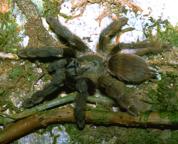 Here's a photo of a tarantula that I found on my night hike while
I was looking for amblypygids. It's probably a Psalmopoeus reduncus (thanks to Danny Granse for the ID).
Here's a photo of a tarantula that I found on my night hike while
I was looking for amblypygids. It's probably a Psalmopoeus reduncus (thanks to Danny Granse for the ID).
Other researchers I met included a couple from UC Davis. The guy was
doing a post-doc and his girlfriend was just starting graduate school
there. They wanted to check out La Selva as a possible location to do
research, and they had combined their visit with a general tour of
Costa Rica. The guy was interested in the poison dart frogs, and
since Bob was the Earthwatch team's local expert, he told them where
they should go to find the frogs -- out on the STR trail. The next
day, Bob and I were doing the nectaries on the STR trail and had just
finished when the UC Davis folks walked past. Since we were all
obviously headed back to the station for lunch, we walked together.
They commented that they'd seen lots of great stuff, but that they'd
had no luck finding a poison dart frog. Within a minute, Bob showed
them one ... then another ... then another ... then another. Clearly
Bob had the proper frog search image!
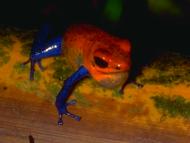 Here is a male poison dart frog calling. If you look closely,
you can see that his throat is expanded.
Here is a male poison dart frog calling. If you look closely,
you can see that his throat is expanded.
I really enjoyed talking to them, and I sat with them for a few meals.
It was too bad that they only had a couple of nights at La Selva and
none of those overlapped with our time off or I would have gotten to
know them better.
Finally, there was the "canopy babe", also known as Kat. I never really talked to her, but she and her friend Eddie always came late to dinner, usually covered with mud. I did talk to Eddie. He's from Iowa and was studying trees at La Selva. He had good reason to be in Costa Rica. As he said, "There's only one species of tree in Iowa, and that's corn."
Anyway, I think Grant was pretty jealous of Kat. Apparently when National Geographic visited La Selva a couple of years ago for an article about the rainforest canopy, since Kat was doing canopy research, she got all the glory, including photos in National Geographic. Grant was particularly jealous because apparently at the time, she had just begun her work, and and Grant (or almost any other biologist) would have been equally qualified. But now Kat's officially the "canopy babe" -- it says so in National Geographic.
They ran little one or two day experiments to learn about various plants and animals and often presented their results in talks. We thought they were a pretty reserved group until the final night.
At the end of each week in an OTS station, they always celebrated with a barbaque and lots of beer. We had a few beers with them, and then somebody had the great (?) idea of taking taxis to the town of La Virgen for a fiesta. About ten of us (but none of the course participants) got into taxis and took off at about 8 pm. The fiesta turned out to be a giant disco party held in a barn with the music volume at earsplitting levels. At about 11 pm we got a taxi back and noticed that the OTS course students were in the cafeteria, playing a game of "strip spoons".
To play spoons, you put one fewer spoon than there are participants on a table and deal out a deck of cards to everybody. Then the players, all standing around the table, repeatedly discard a card to the person on the right and pick up the card on their left as fast as possible. As soon as somebody gets four of a kind, he/she grabs a spoon. As soon as the first person lunges for a spoon, so does everybody else, and the person without a spoon at the end loses one piece of clothing. They were only taking off shoes and socks when we went by, so I don't know how it ended.
Toward the end of our project a family consisting of mother, father, and four kids (one boy and three girls) stopped at La Selva to spend two nights there. I noticed them as they checked in at about noon, but I didn't have any contact with them until that evening at dinner. The oldest child was a girl aged about 13 or 14, and the others were each about 2 to 4 years younger than the next, making the youngest about 3 or 4. As they entered the dining hall, I overheard the father tell the kids that they should each go to a different table to meet all the researchers. The kids did so, and the oldest daughter sat with a bunch of us. "Hi. My name is Rebecca. What's yours?", she started confidently.
So we started talking to her, but she was so confident of herself and full of annoying questions that pretty soon we started to lose our patience. I know it sounds difficult to believe, but it only took about 5 minutes before she really got on our nerves. Katie was sitting at the table, and she began to get redder and redder in the face, clamped her mouth shut, and began aggressively picking at her hands. When Rebecca left the table for a moment for more to drink or something, Katie blew up and started ranting about the kid. Finally the meal ended, we took off, and I thought that was the end of it.
I always woke up early when the sun rose, so I almost always walked over to the dining hall at 6:00 am when it opened. Normally I took over a set of binoculars to do some bird-watching until somebody else showed up, and then I'd go in to breakfast with whoever it was so I'd have some company.
But the morning after the family arrived, there was a line of the permanent researchers standing outside the dining hall even before 6. I sat down with them, and they were wolfing down breakfast, which I'd never seen before -- usually breakfast was pretty relaxed and we'd sit and talk afterwards since most of the work didn't start until 7:15 or 7:30. They said that they were trying to avoid the family.
I said something like, "Say no more -- I met the oldest daughter last night."
"But did you meet the father?", was the response. "We were stuck with the father at our table for dinner, and when you left, the oldest daughter joined him."
I said something about how she was pretty obnoxious all right, but what was wrong with the father?
"Well, when you meet the daughter, your first impression is, 'What an obnoxious asshole!', but after you meet her father, you find yourself thinking, 'What a poor little girl!'"
It turned out that the family had glued itself to the researchers after dinner and had followed them back to the lab. They demanded to be taken out the next day on the various research projects, they sat behind them while they read and responded to email, and the questions never stopped. Apparently the classic line for that night was from the father when one of the computer screens had a picture of a tapir on it as a sort of screen saver. One of the kids asked, "What's that?", to which the answer was, "It's a tapir -- they're really cool." The father then demanded to know "Exactly why is it cool?"
The son Charles is in second grade, and had informed the folks at his table that there was really no point in his going to school since he already knew everything. Rebecca learned that as part of our research we were climbing up into the canopy on ropes to look for caterpillars there, and she demanded to be allowed to climb with us. She wouldn't take "no" for an answer, but it didn't do any good -- we never let her anywhere near the tree.
The baby was a baby, and the second oldest daughter seemed almost normal -- she told her people about catching lizards, about how bad insect repellent tastes, et cetera, but the father, Rebecca, and Charles drove us nuts. The mother also seemed normal, but she hardly ever said anything. She did seem surprised that we considered flashlights a requirement after dark, and wanted our assurance that the snakes would all race away from you if you approached them. She never got that assurance.
For that reason, all the researchers were hell-bent on eating and getting out in the field before the family made it to breakfast so that they wouldn't be followed. We did manage to do this.
I had already planned to miss the following lunch because I was trying to do 8 sets of nectaries, so I'd ordered a sack lunch, and because of that I missed the scene at noon. The tables each hold 6 people, but you can add one at each end so there's room for 8 people to eat comfortably if they get rid of their trays. That noon, the Earthwatchers jammed 13 people at one table!
At dinner, everyone at La Selva had it down to a science. We gathered outside the dining hall, and as soon as ten people were there, they'd enter in a group and then all go to the same table. If you leave on a couple of trays and put all your flashlights and umbrellas on the table, it's crowded enough that nobody else would think of trying to squeeze in. Then you all have to leave at once at the end.
I know it seems strange that any family could have an effect like this, and that our actions were pretty infantile, but our actions were all unanimous, and no one expressed any remorse for behaving the way we did. And one more breakfast at 6 am on the dot solved the problem.
At the launch site, there's a sign that warns of "deep water and strong currents", so I was pretty thankful that about half of the volunteers who were considering a swim backed out and walked home. But Katie, Claire, Bob, Nick, Sylvia and I plunged in and had a fantastic ride back home. All of us were pretty strong swimmers so nobody had any problems, but there were a couple of snags along the way to make things interesting. The ride was so much fun that Katie, Claire, Bob and I took a second run.
In fact, on her day off, she and Claire went to the research swamp hunting for leeches, and although they had an entertaining day walking across rotting wooden walkways and occasionally breaking through and falling into the slime, they found nothing. Katie decided that perhaps the correct approach was to go at night, and who could pass up an adventure like that?
The research swamp was quite a distance from the dorms, so we decided to try a nearby swamp on the "Cantaranas" (singing frogs) trail. It proved to be ideal -- the walkways were in good shape, so there were no unintentional plungings into the swamp, and in fact you could sit on the walkway and dangle the bait over the edge into the water. The bait, of course, was Katie's legs.
I "helped" by shining my light in the water and by assisting with the leech removal that naturally followed. I was amazed how quickly they found her. The first dip was for about 45 seconds, but after that, we found she could get three or four of them with only a 10 second immersion. An acquaintance of Katie's (boyfriend or brother or something) had apparently gotten leeches in Morocco the previous year, and Katie was determined to get more than he had, so she kept "fishing" until she was certain that she'd passed his mark. She kept her collection in a plastic bag filled with water for a day or two, but she eventually decided to return them to the swamp.
After the leech hunt it was still early, so we returned to the site of the amblypygid hunt with our flashlights to go on a scorpion hunt (Katie had foolishly passed up the opportunity to hunt the amblypygids), but we had no success in that endeavor, although we did see the red-eyed jungle frogs, amblypygids, and spiders galore.
An adult botfly looks pretty much like a large housefly, but its larva is a maggot that lives under the skin of some large mammal -- it could be a horse, or cow, or tapir, or even a ground monkey. The eggs are not placed directly on the hosts by the adult botfly; they take the slightly less dangerous approach of laying them on mosquitos or other biting flies, and when those insects come in for a drink of blood, the botfly egg almost instantly hatches into a larva that burrows in where the mosquito or fly landed.
Normally, there's no discomfort associated with a botfly, but a couple of times a day, it has to enlarge its burrow, and as it rasps out tissue it can be pretty painful. Grant said it wasn't too bad, and that the "reward" of seeing the adult emerge was well worth the couple of painful episodes per day. Every couple of days he proudly displayed the lump on his ankle.
The rest of us used bug repellant!
To climb a tree, you use a crossbow to shoot a dart attached to a cord over a branch. Then (assuming the dart doesn't get lost or tangled), you tie a heavy rope to the cord and pull that over the branch. You then test the strengh of the branch by gingerly applying more and more weight to it, being ready to run like hell if you hear a sudden "snap" high above your head.
When you're finally convinced that the branch may hold your weight, you climb up the rope in a manner to be described later. Once you get up the first time, you can rearrange things, find stronger or better branches, and set things up for future climbs with additional ropes, et cetera.
We all climbed the same tree that had been carefully set up and thoroughly tested. In addition to the rope that you climb, there was an additional rope through a sort of pulley (actually a pair of carabiners) in the tree hooked to a different branch from the climbing rope. This additional rope was for "belay", or protection for the climber.
To ascend the tree, you put on a harness that goes around each thigh and around the waist. To the harness is connected the belay rope so if you somehow fall, you're connected to a person holding the other end on the ground through a pulley above your head. Also connected to the harness is a "Jumar ascender" -- a little device that hooks to the climbing rope, and can be slid along the rope in one direction, but if you try to move it in the opposite direction, it locks onto the rope. Finally, there's a second Jumar hooked to a sort of rope ladder into which you put your boots.
The belay rope is only for protection during the ascent, and all the guy on the ground does is to keep that rope slightly taught so that if you fall, you'll only drop a few inches before the rope catches you. The climber has to do all the actual work of climbing. Although it's a little difficult to get started, once you're a bit off the ground, the principle is pretty easy. Assuming that you are sitting in your harness, hanging from the climbing rope, you bend your knees, bringing your feet close to your body. Now the ladder will be very loose, so you can slide the Jumar connected to the ladder up the climbing rope. Then you transfer the weight to your feet, and stand up. The Jumar connected to the ladder locks in place, and after you're standing, there's no weight on the harness around your waist, so you can push up the Jumar connected to it, sit down, and you've now advanced a few inches up the rope. Repeat the process over and over, and you can climb as high as you want. Assuming you are doing it right, it's just like doing a long series of deep-knee bends to get up the rope.
When you first try it, climbing can be totally exhausting, either because you are in too much of a hurry, and you try to take steps that are too large, or because you use your arms to try and lift yourself instead of using your legs. Lee (who's apparently quite a good mountain climber) suggests limiting yourself to using a single finger to touch the Jumars. Then there's no chance that you'll try to use your arms to lift yourself up. Everybody on the team did a significant amount of climbing, although not everyone made it all the way to the top. But just getting half of the way up gave a pretty nice view, and I think everyone was pleased with their efforts.
Coming down was also interesting. The idea was to simply disconnect yourself from the climbing rope (by disconnecting the Jumars), and then to let the person belaying you from the bottom let you down slowly. You have to be sure to disconnect in the correct order, or you can wind up stuck on the rope, and the only way to correct the problem is to reconnect the Jumars, climb a little bit to relieve the tension, and then to try again.
Unfortunately for Nick (and fortunately for the rest of us), Nick has been a climbing instructor, so he got "volunteered" to help with the belays on many of the tree climbs, leaving Lee and Grant free to do some biology. When it was my turn, I went up first with Nick belaying, and with Bob and Lindsay waiting at the bottom of the tree. As I went up the rope the sky got blacker and blacker, and when I got down and we were deciding whether to hook Bob into the rope Grant came by and said "Run!". We only made it about 100 meters toward the lab when the rain really cut loose, and so running really was sort of pointless as we were all totally drenched by the time we got back.
In the middle of the arboretum, there's a nice gazebo where you can sit and relax.
But apparently at night is when the gazebo really comes to life. It's the chief make-out spot for the long-term researchers. There's a broom there for sweeping off the floor (in case you need to lie down on it for some reason), and all sorts of candle stumps on the railings that apparently add to the romantic mood. You're not likely to be surprised there, either -- the gazebo's at the top of a hill and you could see anyone else coming at night from a long way off, due to their lights. And given the number of terciopelos said to be found in the arboretum, you can be guaranteed that any visitors would have their lights on.
Grant was said to be an expert in the use of the gazebo.
Since there wasn't much else to do, a half-dozen of us crammed into the lounge with all the rest of the staff and started watching the videos. They were very good, aimed at kids, but they were at a sort of elementary nature. But then I noticed that all the filming was at La Selva, and we kept seeing more and more familiar locations. Finally, the reason for the interest became clear -- almost everyone on the staff had become television stars, with bit parts in the shows.
For example, when John Acorn was talking about the bullet ants, he mentioned that the sting is fairly painful. He then rhetorically asked, "How painful is it?", and this was followed by tiny segments of all the staff: "It really hurts.", "It feels like a bullet going in.", "I've been stung 27 times, and it's horribly painful!", et cetera.
I'd never seen nor heard of the show, but from the three examples I saw, it seemed to be very well done.
Suzanne and I were pretty much opposites in our assessment of La Selva. I could have stayed for weeks longer, and she got pretty tired of the accommodations and food toward the end. In comparison with a couple of the other Earthwatch trips I'd done, this one had fabulous accommodations, but one night Suzanne (or somebody) overheard a couple of the long-term researchers talking, and one asked the other how his research was going. The reply was, "It's just one big fucking nightmare!" Suzanne, of course, decided that "One Big Fucking Nightmare", or "OBFN" should appear prominently on the T-shirt she was mentally designing for the group members. I think the shirt was also to contain pictures of bullet ants, of caterpillar frass, and venomous snakes.
To bring the whole adventure full circle in a Finnegan's Wake-esque manner, the final meal was in an Italian restaurant again, and for dessert, I had tiramisu.
Return to my home page